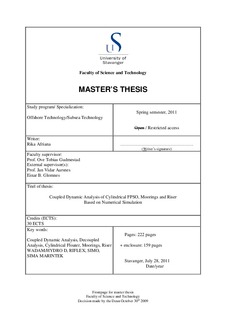| dc.description.abstract | The hostile environments are presently one of the challenges that should to be deal with in offshore floating system design where the hydrodynamic interaction effects and dynamic responses dominate the major consideration in its design.
Nowadays, the cylindrical FPSO is being extensively used as an offshore facility in the oil and gas industry. This system has been deployed widely around the world as a unique design facility which is regarded as a promising concept. As a floating offshore system, a cylindrical FPSO will be deployed together with slender members (moorings and risers) responding to wind, wave and current loading in complex ways.
In order to quantify the coupling effects between each component in an offshore floating system and the associated structural response in offshore structure design, two kind of analyses, the decoupled analysis and the nonlinear-coupled dynamic analysis have been presented in this thesis. It introduces a consistent analytical approach that ensures higher dynamic interaction between the floater, moorings and risers. The nonlinear-coupled dynamic analysis requires a complete model of the floating offshore system including the cylindrical S400 floater, 12 mooring lines and the feasible riser configurations for the 6” and 8” production risers. Furthermore, the results from the nonlinear-coupled dynamic analysis will also be compared to the separated analyses for each component as a discussion of the analysis results.
The frequency domain and time domain analysis will be implemented to solve the equation of motions at the simulations. The simulation will be conducted in two simulation schemes, static and dynamic conditions. The 3 hours + build up time will be used in the dynamic condition because the time domain requires a proper simulation length to have a steady result.
Several software computer programs will be used in the analyses. In the separated analysis for each component in offshore floating system, the cylindrical floater hydrodynamic analysis as a decoupled analysis is performed by using the integrated software program Hydro D which is related to several support software programs (Prefem, Wadam and Postresp). For mooring system analysis as a decoupled analysis will be analyzed by using SIMO in time domain analysis. In SIMO, two models (the body model and the station keeping model) will be required and the quasi-static design will be applied as the design method in mooring system analysis. The analysis for riser system also is done as the decoupled analysis in this study. The main purpose of this analysis is to find a feasible single arbitrary configuration for each of the 6” and 8” production risers. The riser system analysis will also be performed in time domain analysis in RIFLEX for two simulation conditions, static and dynamic conditions.
After the separated analyses for each component, a single complete computer model that includes a cylindrical floater, moorings and risers with use of SIMA will be as the nonlinear-coupled dynamic analysis. The analysis is performed in time domain for two conditions, static and dynamic conditions. The SIMA Marintek computer will be used in this study because it has the capability to integrate the cylindrical S400 floater, moorings and risers as one complete model. As an integrated dynamic system, the environmental forces on the floater induce the motions which will be introduced in a detail FEM (Finite Element Model) of the moorings, risers and cylindrical S400 floater.
In the end, not only the accurate prediction of the responses of the overall system but also the individual responses of the floater, mooring and risers are obtained. The summary of results between the decoupled analysis and the nonlinear-coupled dynamic analysis will also be presented briefly in this study. | no_NO |
